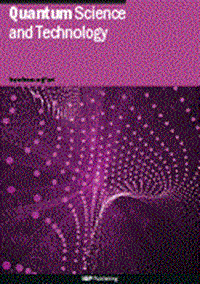探索半导体量子比特:四量子点硅器件的模拟
IF 5
2区 物理与天体物理
Q1 PHYSICS, MULTIDISCIPLINARY
引用次数: 0
摘要
量子计算代表了一种革命性的计算范式,具有克服经典计算机局限性的潜力。在正在研究的各种方法中,基于半导体的解决方案作为量子比特实现的有前途的候选者脱颖而出。本研究探索了一种四量子点SiGe异质结构。利用基于低级有限元方法的模拟器量子技术计算机辅助设计(QTCAD)对上述结构进行了分析,得出了实现电子自旋量子位的关键物理参数。尽管QTCAD可能不像真实实验那样准确,但它仍然提供了对设备行为的重要见解。目的是利用这些模拟来有效地分析器件对结构参数变化的响应,并确定其是否适用于实际应用。因此,可以通过简单地修改模拟代码来改变结构,避免了重复和昂贵的光刻工艺的需要。值得注意的是,这是第一次使用QTCAD分析四量子点系统。具体而言,该研究涉及求解非线性泊松方程以及单粒子和多粒子Schrödinger方程。此外,还进行了输运分析,得到了库仑峰、库仑菱形和电荷稳定性图。最后,计算了隧道系数和不同点对之间的交换作用能的近似值。研究结果为设计能够执行多个量子逻辑门的高级逻辑电路提供了基础。通过利用对量子点配置的精确控制,可以为特定的计算目的定制量子态之间的相互作用。这种方法可以实现复杂的架构,其中单个量子点充当量子网络中的量子比特或节点。调节门电压和控制点间耦合的能力允许实现复杂的量子逻辑门。本文章由计算机程序翻译,如有差异,请以英文原文为准。
Exploring semiconductor qubits: simulation of a four quantum dot silicon device
Quantum computing represents a revolutionary computational paradigm with the potential to overcome the limitations of classical computers. Among the various approaches under investigation, semiconductor-based solutions stand out as promising candidates for qubit implementation. This work explores a four-quantum dot SiGe heterostructure. The above structure has been analyzed using the low-level finite element method-based simulator quantum technology computer-aided design (QTCAD) to derive essential physical parameters critical for implementing electron spin qubits. Even though QTCAD may not be as accurate as real experiments, it nonetheless provides important insights into the device behavior. The aim is to use these simulations to effectively analyze the device’s response to changes in structural parameters and determine whether it is feasible for real-world applications. As a result, changes to the structure can be made by simply modifying the simulation code, avoiding the need for repetitive and expensive lithographic processes. Notably, this is the first time a four-quantum-dot system has been analyzed using QTCAD. Specifically, the study involves solving the non-linear Poisson equation as well as single and multi particle Schrödinger equations. Additionally, a transport analysis is performed, yielding Coulomb peaks, Coulomb diamonds, and charge stability diagrams. Finally, an approximation of the tunneling coefficient and the exchange interaction energy between the different dot pairs is computed. The results provide a foundation for the design of advanced logic circuits able to execute multiple quantum logic gates. By leveraging the precise control over quantum dot configuration, it becomes possible to customize the interactions between quantum states for specific computational purposes. This approach enables the realization of complex architectures where individual quantum dots act as qubits or nodes in a quantum network. The ability to tune gate voltages and control inter-dot couplings allows for the implementation of complex quantum logic gates.
求助全文
通过发布文献求助,成功后即可免费获取论文全文。
去求助
来源期刊

Quantum Science and Technology
Materials Science-Materials Science (miscellaneous)
CiteScore
11.20
自引率
3.00%
发文量
133
期刊介绍:
Driven by advances in technology and experimental capability, the last decade has seen the emergence of quantum technology: a new praxis for controlling the quantum world. It is now possible to engineer complex, multi-component systems that merge the once distinct fields of quantum optics and condensed matter physics.
Quantum Science and Technology is a new multidisciplinary, electronic-only journal, devoted to publishing research of the highest quality and impact covering theoretical and experimental advances in the fundamental science and application of all quantum-enabled technologies.
 求助内容:
求助内容: 应助结果提醒方式:
应助结果提醒方式:


